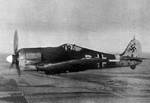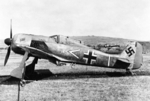Fw 190 Würger
| Country | Germany |
| Manufacturer | Focke-Wulf Flugzeugbau GmbH |
| Primary Role | Fighter |
| Maiden Flight | 1 June 1939 |
Contributor: C. Peter Chen
ww2dbaseThe prototype Fw 190 Würger ("Shrike") aircraft flew on 1 Jun 1939. The maneuverable and speedy aircraft very quickly made a good impression on the Luftwaffe officers, and by late 1940 they were seen on the front lines, though they did not serve in combat roles until Aug 1941. Engine reliability issues caused by overheating, however, plagued Fw 190 fighters until spring of 1942 when BMW engines arrived. With the engine reliability issue resolved, they were seriously considered for ground attack roles. The Germany Army considered them a good candidate for close ground support because there were no liquid cooling systems that were vulnerable to battle damage; the BMW radial engines were air cooled. The sturdy and wide undercarriage also made them ideal for landing and taking off from crude airfields on the front lines.
ww2dbaseWhen the British first encountered Fw 190 fighters, they had no idea they were facing a new type of aircraft; the British pilots thought they were facing captured French fighters, but the outstanding performance of the hostile German aircraft eventually generated some suspicions. It was not until the British captured one in Jun 1942 before they confirmed it was a completely new German design. It was not until that time the British realized the Germans had the potential to outclass the sluggish Spitfire fighters with the Fw 190 aircraft.
ww2dbaseJapan was given a Fw 190 fighter of the A-8 variant by Germany for technical evaluation. The results of the study by Japanese engineers were incorporated in the design of the Ki-61 fighter.
ww2dbaseAltogether, 20,051 were delivered during the war.
ww2dbaseSources: Aircraft of the Second World War, Spearhead for Blitzkrieg; Wikipedia.
Last Major Revision: Mar 2007
Fw 190 Würger Timeline
| 1 Jun 1939 | The Focke-Wulf Fw-190 fighter made its maiden flight at Bremen, Germany. The aircraft displayed excellent handling characteristics and was highly maneuverable but suffered from engine overheating problems which required the fitting on a redesigned engine cowling to overcome. |
| 23 Jun 1942 | Anxious to learn the secrets of the Luftwaffe's new Focke-Wulf 190 fighter, the British was planning a Commando-type raid to steal one from a French airfield. They were saved the trouble when disorientated German pilot Lieutenant Arnim Faber of 111/JG2 landed his Fw 190A-3 fighter at RAF Pembrey in South Wales, United Kingdom, mistaking it for an airfield in France. The captured aircraft was taken to the Air Fighting Development Unit at Duxford, England, United Kingdom where it was discovered, during trials, that the Fw 190A was superior in all respects except turning circle to the Spitfire VB then equipping most of RAF Fighter Command. |
| 3 Nov 1944 | Fw 190 prototype aircraft V21 completed its rebuilding as the first Ta 152C prototype. |
SPECIFICATIONS
A-8
| Machinery | One BMW 801Dg 18-cyl two-row radial engine rated at 1,700hp (2,100hp with boost) |
| Armament | 2x13mm MG 131, 4x20mm MG 151, optional 1x500kg bomb |
| Crew | 1 |
| Span | 10.51 m |
| Length | 9.00 m |
| Height | 3.96 m |
| Wing Area | 18.30 m² |
| Weight, Empty | 3,200 kg |
| Weight, Loaded | 4,900 kg |
| Speed, Maximum | 653 km/h |
| Service Ceiling | 11,410 m |
| Range, Normal | 900 km |
D-9
| Machinery | One Junkers Jumo 213A-1 12-cyl inverted-V liquid cooled engine rated at 1,776hp (2,240hp with boost) |
| Armament | 2x13mm MG 131, 4x20mm MG 151, optional 1x500kg bomb |
| Crew | 1 |
| Span | 10.50 m |
| Length | 10.20 m |
| Height | 3.35 m |
| Wing Area | 18.30 m² |
| Weight, Empty | 3,500 kg |
| Weight, Loaded | 4,840 kg |
| Speed, Maximum | 704 km/h |
| Service Ceiling | 10,000 m |
| Range, Normal | 900 km |
Photographs
 |  |
Please consider supporting us on Patreon. Even $1 per month will go a long way! Thank you. Please help us spread the word: Stay updated with WW2DB: |
Visitor Submitted Comments
20 Apr 2008 12:27:47 PM
Ki-61 was influenced by Me-109 and not FW-190, as it was build on a derivative of DB601 liquid-cooled engine.
Just look at the aircrafts - FW has a radial engine :)
15 Apr 2011 03:43:30 AM
FW's were not only produced with radial engines, but also with inline engines.
1 Jun 2014 06:55:13 AM
Mr. Doi, the engineer who developed Ki-100 (Type 5 fighter, radial-engined version of Ki-61) admitted the exhaust layout was influenced by FW190 as he found it as ideal solution.
1 Jun 2014 09:14:12 AM
"Joe, they maybe at talking, not the ki61, maybe of the Ki100, that ar a Ki61 with radial engines.
10 Dec 2014 07:55:26 PM
There seems to be much vagueness regarding the top speed of the 190D. Most references claim a top speed of 426mph at 22,000 feet, but others state 440mph at 40,000 feet. I suspect the latter claim was based on the use of nitrous oxide boost, but no text actually states this. Can anybody out there shed light on this?
16 Jul 2017 12:22:48 AM
The Focke-Wulf Fw190D-9 was armed with only two 20mm MG 151 cannon (not four as stated here). On the D-9 the outboard cannons were deleted to allow for a MW 50 (methanol-water) power boost which raised the power of the Junkers Jumo 213A-1 engine from 1,776 h.p. to 2,240 h.p. for take-off. The methanol-water mixture was carried in a 25 Imperial gallon tank aft of the cockpit and was sufficient for 40 minutes’ use. The D-9 became operational with J.G.3 (Jagdgeschwader Udet) at Detmold in the winter of 1943-44, and proved an immediate success when employed against Allied bombers.
All visitor submitted comments are opinions of those making the submissions and do not reflect views of WW2DB.

» Carrier Aircraft Specifications
- » 1,181 biographies
- » 337 events
- » 45,132 timeline entries
- » 1,249 ships
- » 350 aircraft models
- » 207 vehicle models
- » 376 weapon models
- » 123 historical documents
- » 261 facilities
- » 470 book reviews
- » 28,427 photos
- » 365 maps
James Forrestal, Secretary of the Navy, 23 Feb 1945
16 Dec 2007 04:24:45 AM
Production of the High-Altitude Ta.152H-1 fighter began on November 21, 1944 but only ten had been completed by the time that the war came to an end.